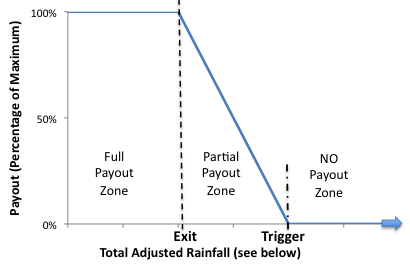3. Understanding a Drought Index
3.1. Topic: Understanding a Drought Index
3.1.1. Objective
The objective of this section is to help the reader learn how to understand the particular aspects and features of a simple index insurance contract. Topics covered include how index insurance payouts are determined using triggers and exits, contract features such as the contract ‘window’ and contract ‘phases’, and how and why to ‘cap’ your index measurements. To make the analysis more concrete, we use adopt the specific example of a drought index insurance contract throughout this section.
3.1.2. Introduction: Review of Index Insurance Contracts
Insurance contracts, in this case, are agreements between farmers and an insurance company. By signing an index insurance contract, the farmer agrees to pay a certain amount of money (called the premium) to enroll in the index insurance program. In return, if the contract is for drought insurance, then after the season (or contract window) is finished, if the rainfall is less than the amount agreed upon, the insurance company agrees to compensate the farmer. Participation in an insurance contract is voluntary and, typically, is only for one year; which is to say that the farmer must agree to the contract every year.
3.1.3. Description of some important contract components:
Determining Payouts using Triggers and Exits: During the dates covered by a drought index insurance contract (often these dates are called the ‘contract window’), the amount of rainfall measured by satellite or rain gauges determines if any payout is received. Each contract window has what is called a ‘trigger’; if the total rainfall amount is more than the trigger, there is no payment. Any rainfall total below the trigger will result in a payout. Payments will increase for each millimeter (mm) that rainfall falls further below the trigger, until a maximum payment is reached. The maximum payout point is called the index ‘exit’. To summarize, if the total rainfall for the contract dates is above the trigger, you will receive no payment. If the rainfall is between the trigger and exit, you will receive a partial payment. If the rainfall is below the exit, you will receive a full payment. The figure below illustrates how the payout is determined by the trigger and exit values:

Contract Window: The contract window specifies the period of time during the cropping season to which the index insurance contract applies. Typically, an index insurance contract will have both a start and an end date during which the index value is measured. A drought insurance contract, for example, will only pay out if measured rainfall is below the index’s trigger value during the period specified by the contract window. If rainfall is low outside of the dates specified by the window, the contract will not pay out.
Measuring Rainfall: Using a Cap: Please note that the rainfall total we use is actually an adjusted rainfall total. Every ten-day period (dekad) the rainfall amount is totaled, and a ‘cap’ (e.g. 25 mm) is applied. This cap represents the maximum amount of rainfall that is counted for each ten-day period. These adjusted ten-day rainfall totals are then added together to calculate the adjusted rainfall total for the full contract window. A cap is applied so we can better capture dry spells. Without this feature, it would be possible to have a single big storm drop enough rainfall in a short amount of time to pass the contract trigger; however, you might still have very dry crops on all other days (while most of the water from the big storm would be washed away before it could be used by the plants). As a result of this adjustment, the contract triggers and exits are also not truly represented in units of millimeters. Instead, you may want to think of the trigger and exit as ‘capped millimeters’.
Contract Phases: In some locations, farmers have identified multiple critical periods in which their crops are vulnerable to drought. It is possible to develop an index that targets different phases (or windows) within the growing season. In a multiple phase contract, each phase can have a unique trigger, exit and payout frequency. However, not all crops and locations require a multiple phase insurance contract; a one-phase contract (only looking at one part of the season) is also possible. Ultimately, the decision on which (and how many) phases to use will depend on local needs.
Please Remember That: Drought index insurance will not pay out in every year, and it will not cover all farmer risks. There are many things drought index insurance is NOT designed to help with, like floods or termites. You will not receive a payment in most years, and you will not receive a payment in all ‘bad’ years. This insurance cannot be used to address every risk; rather it is designed to be one part of a larger risk management package.
3.2. Checkpoint: Understanding a Drought Index
Note: This is an example drought index insurance contract for a village, based on the R4 project in Ethiopia. The farmer design team has indicated that rainfall is very important in two parts of the planting season, so a two-phase contract was developed. Basically, these two phases can be treated as two separate contracts, since it is possible for the payment of insurance to be triggered in either part of the season. For the questions below, we will only be examining the first phase of the contract (i.e. we will only look at the first and second columns of the table).
| Title | Phase 1 | Phase 2 |
|---|---|---|
| Start Period: (Dekad*) | May-1 (13) | 21-Aug (24) |
| End Period: (Dekad*) | 30-June (18) | 20-Sep (26) |
| Trigger (mm) | 13 | 30 |
| Exit (mm) | 7 | 20 |
| Cap (mm/dekad*) | 25 | 25 |
| Historic Years | Phase 1: Percent of Max Payout Received (%) | Phase 2: Percent of Max Payout Received (%) |
|---|---|---|
| 1995 | 0 | 0 |
| 1996 | 0 | 0 |
| 1997 | 0 | 51 |
| 1998 | 0 | 0 |
| 1999 | 0 | 0 |
| 2000 | 97 | 0 |
| 2001 | 0 | 0 |
| 2002 | 0 | 0 |
| 2003 | 0 | 0 |
| 2004 | 8 | 0 |
| 2005 | 0 | 0 |
| 2006 | 0 | 0 |
| 2007 | 0 | 0 |
| 2008 | 0 | 0 |
| 2009 | 74 | 0 |
- a dekad is a period of ten days
Questions: (Using the first phase of the contract only)
- What is the start date of the phase 1 contract? __________________
- For the start date, what does the number in parentheses represent? _______________
- What is the end date of the phase 1 contract? ____________________________________
- What is the trigger of the phase 1 contract (mm)? What does this mean? ___________
- What is the exit of the phase 1 contract (mm)? What does this mean? ______________
- If the total rainfall during the contract window is 10mm, will there be a payout? If Yes, would this be a partial or full payout? ______________________
- What is the maximum amount of rainfall that is counted for each dekad? ____________
- According to this example contract, how many phase 1 payouts would there have been in the last 15 years? _______________
- What years would have paid out for the 1st phase? _____________________
- Which year would have paid out the most? What percentage of a maximum payout? Why does the percent of maximum payout received change for different years? _______________
